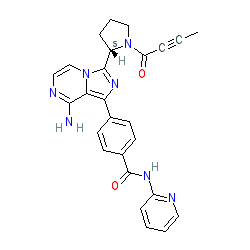GtoPdb is requesting financial support from commercial users. Please see our sustainability page for more information.
|
Synonyms: ACP-196 | Calquence® | Example 6 [US20140155385 A1] [2]
acalabrutinib is an approved drug (FDA (2017), EMA (2020))
Compound class:
Synthetic organic
Comment: Acalabrutinib is an orally available second-generation, selective and irreversible inhibitor of Bruton tyrosine kinase (BTK) [6], being investigated for its potential antineoplastic activity (in multiple haematologic malignancies and solid tumours), as well as a potential therapy for rheumatoid arthritis. Acalabrutinib covalently bonds to Cysteine-481 in BTK.
Ligand Activity Visualisation ChartsThese are box plot that provide a unique visualisation, summarising all the activity data for a ligand taken from ChEMBL and GtoPdb across multiple targets and species. Click on a plot to see the median, interquartile range, low and high data points. A value of zero indicates that no data are available. A separate chart is created for each target, and where possible the algorithm tries to merge ChEMBL and GtoPdb targets by matching them on name and UniProt accession, for each available species. However, please note that inconsistency in naming of targets may lead to data for the same target being reported across multiple charts. ✖ |
|
|||||||||||||||||||||||||||||||||||
| Bioactivity Comments |
| Acalabrutinib has improved selectivity, pharmacologic features (rapid oral absorption, favourable plasma exposure and a short half-life for example) and in vivo target coverage compared to the first generation BTK inhibitor, ibrutinib [3,6]. The IC50 values in the table below are for kinases that contain a cysteine residue aligning with Cysteine-481 in BTK (with exception of LYN). Unlike ibrutinib, acalabrutinib is devoid of activity across the SRC family kinases (IC50s > 1000 nM) [3]. |
| Selectivity at enzymes | ||||||||||||||||||||||||||||||||||||||||||||||||||||||||||||||||||||||||||||||||||||||||||||||||||||||||||||||||||||||||||||||||||||||||||||||||||||||||||||||||||||||||||||||||||||||||||||||||||||||||||||||||||||||||||||||||||||||||||||||||||||||||||||||||||||||||||||||||||||||||||||||
| Key to terms and symbols | Click column headers to sort | |||||||||||||||||||||||||||||||||||||||||||||||||||||||||||||||||||||||||||||||||||||||||||||||||||||||||||||||||||||||||||||||||||||||||||||||||||||||||||||||||||||||||||||||||||||||||||||||||||||||||||||||||||||||||||||||||||||||||||||||||||||||||||||||||||||||||||||||||||||||||||||
|
||||||||||||||||||||||||||||||||||||||||||||||||||||||||||||||||||||||||||||||||||||||||||||||||||||||||||||||||||||||||||||||||||||||||||||||||||||||||||||||||||||||||||||||||||||||||||||||||||||||||||||||||||||||||||||||||||||||||||||||||||||||||||||||||||||||||||||||||||||||||||||||
| Selectivity at catalytic receptors | ||||||||||||||||||||||||||||||||||||||||||||||||||||||||||||||||||||||||||||
| Key to terms and symbols | Click column headers to sort | |||||||||||||||||||||||||||||||||||||||||||||||||||||||||||||||||||||||||||
|
||||||||||||||||||||||||||||||||||||||||||||||||||||||||||||||||||||||||||||










